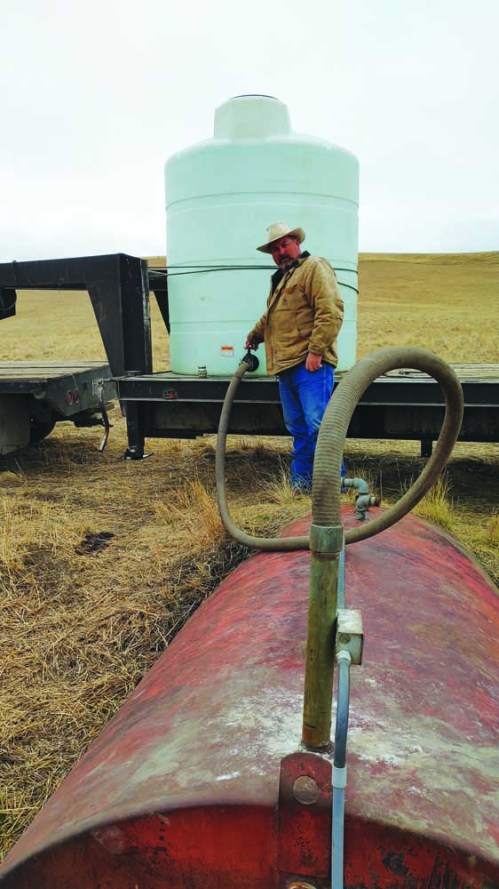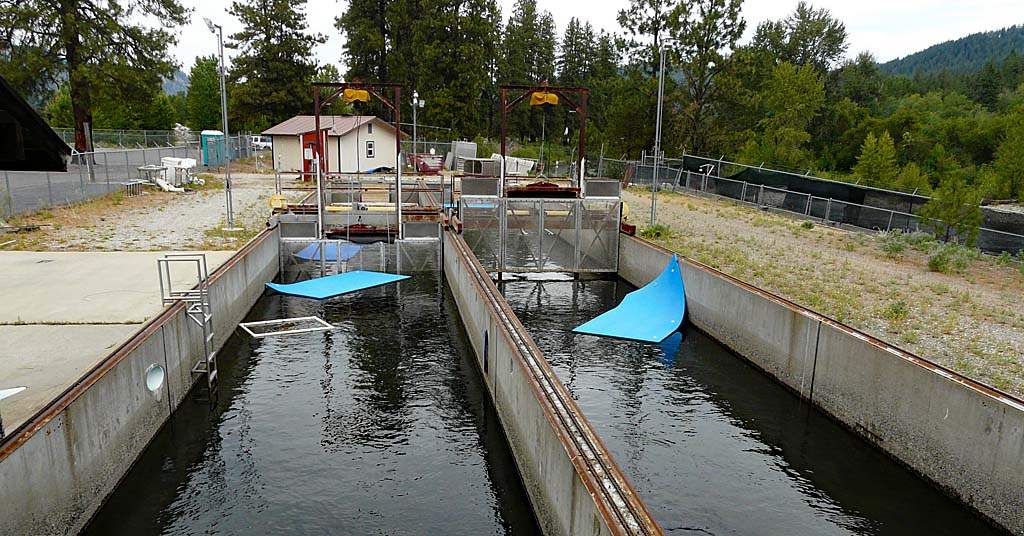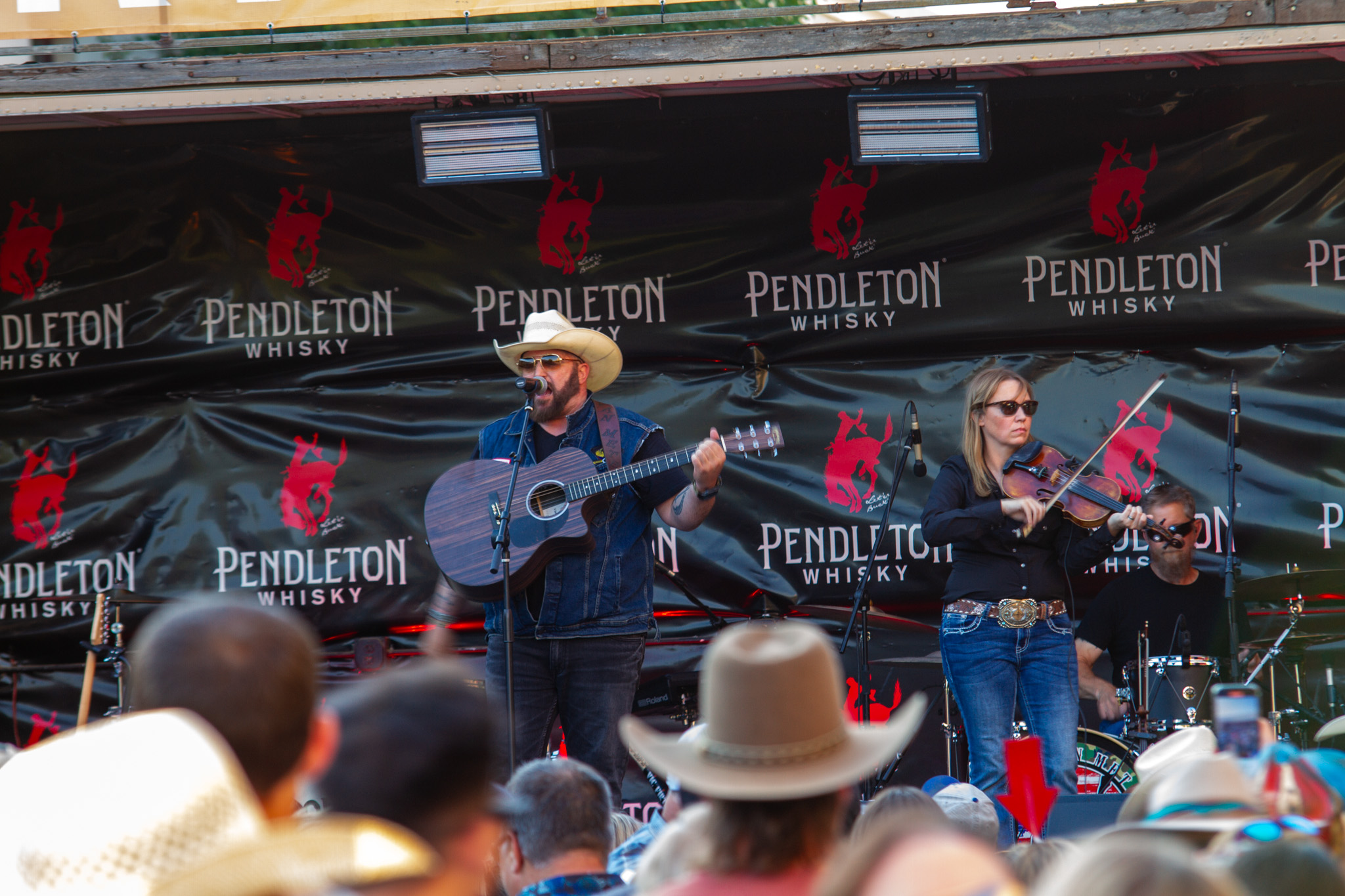Drought steals pounds from cattle, dollars from ranchers
Published 12:45 pm Friday, October 22, 2021

- Wallowa County rancher Todd Nash turns the valve to begin transferring water from a tank into a holding cistern on Oct. 6, 2021. Nash, along with some other ranchers, has had to haul water to his herd due to a lack of water during the drought.
For several weeks, Enterprise cattle rancher Todd Nash has daily filled a 1,000-gallon tank with water from his home just outside town and hauled it to one of his herds, which currently is feeding on land he is renting from the Wade Ranch a couple miles south of Lostine.
A well on the portion of land he is using dried up after about 2 1/2 weeks, resulting in the need to drive the narrow, winding dirt road into the backcountry.
Trending
But Nash knows others in the county have it worse.
“This is fortunate that I’m this close (to home),” he said, estimating he only has to drive around 10 miles one way — though the entire process of filling the tank, navigating the roads once off Highway 82 and emptying its contents into the well or a 3,000-gallon cistern on the land itself can take around three hours. “Some of the guys that are hauling water are quite a lot further out.”
Other ranchers, he said, are hauling much more than the 3 1/2 tons he deals with on a daily basis.
Hauling water to cattle where there is none may be one of the more visible impacts of the drought that has severely impacted Northeastern Oregon — and, really, the West — in 2021.
But it is far from the only one.
Because of the early start to the drought — fueled by a lack of the spring rains that ranchers depend on — many had to adjust on the fly to get needed food into their animals.
Trending
And with cattle, food means pounds, which equates to dollars in value.
Nash, who has been a cattle rancher since 1994, said he’s never seen a year to compare with 2021.
First came an extremely cold April, with a hard freeze almost every night. That was followed by a heatwave, with unusually high temperatures in May and June leading into a scorcher of a summer. And through it all, precipitation was way below normal.
“It set up for the worst grazing season I’ve ever seen in Northeast Oregon,” Nash said. “Even talking to the old-timers here, they’ve never seen such a tough forage year.”
Nash’s operation is relatively small, with only about 100 head of cattle. But as the president-elect of the Oregon Cattlemen’s Association, he talks to lots of other producers to stay abreast of what’s happening around the state, and he’ll tell you that things are rough all over right now.
Throughout the state, extreme weather conditions this year led to poor forage conditions for livestock. The weather also impacted irrigators, leading to a poor hay crop. With hay in short supply and supplemental feed in high demand, the cost of cattle production has soared. Many ranchers also found themselves in the same plight as Nash, having to haul water to thirsty herds as ponds and springs dried up, adding another unanticipated cost to their operations.
Wallowa rancher Dennis Sheehy was forced to feed hay to his herds much longer than usual this spring due to a lack of forage on the range. He had to use about 80% of the hay he hoped to hold for this coming winter.
“We weren’t able to turn out on some of our range land as early as we would (normally),” he said.
Each move made — even though necessary — seems to set off a detrimental domino effect. As the year went on, Sheehy for a time had to turn some of his cattle onto a field he typically cuts hay from — in effect, the animals eating grass that he would normally cut and bale to keep them fed months in the future.
“Then we had lower hay production,” Sheehy said. “That hurts because we have to buy hay for winter. The hay price right now, because of the drought, is so expensive.”
Darren Hansen of Lazy H Cattle in Cove, noted that there is less hay to cut, due to scant rainfall that trimmed yields.
“One of the farmers in the valley, he has the same amount of acres in hay crops, and is down in the normal tonnage he normally does,” Hansen said.
And yet, because of a lack of forage in fields, ranchers not only had to feed hay for longer in the spring, but are starting fall feeding earlier.
“Some of those guys are feeding right now,” Hanse said in early October.
Sheehy has seen this, as well.
“Already some of our neighbors are feeding hay to their livestock,” he said. “They’re getting to where there is no real way to get out on this process.”
A shortage of forage on summer pastures has in many instances led to lighter calves, which are worth less.
“The calves are about 20-30 pounds lighter than they should be,” Hansen said.
Nash noted the same effect.
“(In) a really dry year, you’re going to have some cows that come in on a low body condition score,” he said. “To put that weight back on is really expensive, and nearly impossible with just general hay products.”
Circle back to Hansen, who said that among his lighter-than-normal animals are his breeding cows. The impact here, he said, is that when it comes time to breed for next year’s calves, some of the pregnancies won’t be successful.
“The cows are not near as fleshy as they should be,” he said. “I’m going to have way more open cows than I normally do. If you have a cow that is not in good shape, (then) her body is not fleshy enough to get bred. That will hurt my bottom line next year.”
Hansen also operates a cattle trucking business, which has shown a different, heartbreaking decision ranchers are having to make.
“We’re trucking cattle to slaughter that are bred, because nobody has the hay or the grass to feed them,” he said, noting this action likely will affect the entire cattle supply chain. “We are taking production animals out of the production line and putting them in the food chain because there is no way to feed them.”
Hansen said he already had hauled around 300 bred cows to slaughter for other ranchers who otherwise may see those animals starve or lose the calf.
Nash expressed his view on that reality.
“I think people have reached that point that they’re wondering how they are going to get through the winter, and having to make some really tough decisions,” he said. “And this comes on the heels of quite a few bad years.”
Sheehy noted that ranchers, including himself, are culling their herds more than normal this fall because of a lack of feed and the higher tab for hay they are able to find.
“We’ll be culling heavy, and probably change some of our practices,” he said, noting that he doesn’t yet know what those numbers will be. “Maybe not keep as many heifers back.”
Sheehy’s view is that even if winter brings a bountiful snowpack, and spring rains result in a heavy forage crop in 2022, the effects of this year’s drought could be felt for a while.
“That’s the way I look at it. It’s not just one thing. It’s not (just) a dry year. It’s the convergence of things here that are really hurting the industry,” he said. “If we have even a semblance of a drought next year it’s going to have an impact on people’s ability to raise livestock here.”
We’re just all praying for rain this fall, winter and spring,” Hansen said, “or it will be twice as bad as it was this year.”
Nash said everyone he talks hopes “that we don’t go through this again.”
Baker County
Dean Defrees waited for the grass to grow to its customary green, lush carpet, brushing the bellies of his cattle.
And then he waited some more.
But the grass, deprived of even the occasional rains which are all that can reasonably be expected in arid Northeastern Oregon, failed to respond.
“It was a tough year, and continues to be,” Defrees, whose family has a cattle ranch in Baker County’s Sumpter Valley, said on Wednesday, Oct. 6.
The drought — most of Northeastern Oregon is in extreme drought, the second-worst rating — stunted growth of the grass that Defrees depends on to fatten his cattle herds during the summer and into autumn.
He estimated that forage production on the ranch, which includes meadows and ponderosa pine forests, was down by 10% to 15% from a more typical year.
As a result, Defrees said, he expects to have to start feeding hay to the herd three to four weeks earlier than usual.
Which means a bigger bill for hay, since the Defrees Ranch buys all its winter feed.
And because the drought and record-setting heat this summer had the same deleterious effects on hay yields in many places as on the grass on the Defrees Ranch, he said hay prices are higher than usual, which exacerbates the financial toll.
“We had a couple timely rains here, but not nearly enough,” Defrees said.
For the first nine months of 2021, precipitation at the Baker City Airport totaled 3.58 inches. That’s just 48% of average for the period.
May, which has an average rainfall of 1.42 inches at the airport, the most of any month, brought just 0.57 of an inch this year.
June, which usually ranks as the second-wettest, was even worse, with just 0.21 — 83% below average.
During the first nine months of the year, only one month was wetter than average at the Baker City Airport — and that outlier, August, with 0.65 of an inch, barely surpassed the average of 0.63.
Defrees said he considers himself fortunate in that he has a longtime relationship with his hay supplier. His hay costs are up 20% to 30%, he said.
“I know for others it’s higher than that,” Defrees said.
Heat wasn’t the only problem for ranchers, and for hay growers, this year, Defrees said.
The dilemma during the spring of 2021 was cold temperatures.
The chilly weather, by stunting grass growth, forced many ranchers to feed hay to their cattle further into spring than usual, Defrees said.
That left little surplus hay for sale later in the year, meaning feed for this winter is even more limited, and thus more expensive.
Defrees said the prospect of a longer winter feeding season, with more expensive hay, prompted him to market some cattle earlier than he would have preferred.
That’s likely to be a common situation across the West, said Rob Thomas of the Thomas Angus Ranch in Baker Valley.
He expects a significant liquidation of herds this fall.
The upside, Thomas said, is that ranchers who are able to hold onto most of their animals should be in a position to take advantage of higher prices in 2022.
The Thomas Angus Ranch registered the most Angus beef cattle in Oregon with the American Angus Association during the fiscal year that ended Sept. 30, 2021, according to Mark McCully, CEO for the American Angus Association.
Thomas said the current drought “is the worst that I’ve experienced.”
He said hay production on his ranch was down an estimated 10% to 20% this year.
“We have to hope and pray for a very, very wet winter,” Thomas said.
Grant County
The word for 2021 is “unprecedented,” said Grant County stockman Ken Holliday.
“I’ve seen other bad years in my life … but they pale in comparison to this year,” he said.
Holliday has a ranch between John Day and Prairie City as well as other holdings scattered around Grant County, where he runs more than 900 red Angus and Hereford cross cows and 140 bulls.
The key to getting through a lean year like this one is to be prepared, he said. Last spring, when he saw signs that 2021 could be a historically dry year, he started taking steps to weather the storm.
Among other things, Holliday invested in solar-powered pumps to coax water out of springs that appeared to have dried up. That spared him the expense of having to haul water to his herds.
“We got water where we never had water before,” he said.
Holliday has also investing in hay — not only for this year but for next year as well, which he fears could be as bad as 2021.
“I’m going to buy about 2,000 tons before it’s all over with so when next year comes along and we don’t get enough hay, I’ll have enough to get through,” he said.
Holliday’s advice to his fellow ranchers is to take steps now to be ready for more challenging years to come.
“You’ve got to optimize your production on those meadows and those old water rights,” he said. “Go ahead and bite the bullet, even if you’ve got to borrow money, and go ahead and buy hay for an insurance policy.”
Assessing the beef market
Even though the price of beef has climbed steeply at the supermarket, Nash said producers are being squeezed by low prices for their cattle due to consolidation in the meatpacking industry over the last five years or so.
Nash noted that just four companies — Tyson Foods, Cargill, National Beef and JBS — now process 85% of the cattle raised in this country.
“They’ve managed to get a captive supply of cattle where they don’t have to negotiate prices (with producers),” he said.
All of those stresses have forced many Oregon cattle producers to take drastic measures, Nash said, from culling more older animals to selling parts or even all of their herds.
“Some of them are hoping to get back into it when this is all over, and some have just given up completely,” he said.
Amidst the twin challenges of weather and market forces, Nash shas been heartened by the way some members of the state’s agricultural community have stepped up to help their neighbors in need. And he’s encouraged by the creative approach some ranchers are taking by direct-marketing their beef, which can result in lower costs to consumers and higher profits for producers by eliminating the middleman.
Still, he’s concerned about the future of cattle ranching in Oregon.
“Survivors in this business are survivors for a reason: They’ve been innovative and they’ve done some things to keep costs low,” Nash said. “But there’s only so much we can do with efficiencies. We’re going to have to make some decisions about whether we’re going to stay in this business or not.”









